The ASUS Maximus VIII Extreme Review: The Other $500 Option
by Ian Cutress on April 7, 2016 9:00 AM EST- Posted in
- Motherboards
- Gaming
- Asus
- ROG
- Skylake
- Z170
- Thunderbolt 3
System Performance
Not all motherboards are created equal. On the face of it, they should all perform the same and differ only in the functionality they provide - however this is not the case. The obvious pointers are power consumption, but also the ability for the manufacturer to optimize USB speed, audio quality (based on audio codec), POST time and latency. This can come down to manufacturing process and prowess, so these are tested.
Power Consumption
Power consumption was tested on the system while in a single MSI GTX 770 Lightning GPU configuration with a wall meter connected to the OCZ 1250W power supply. This power supply is Gold rated, and as I am in the UK on a 230-240 V supply, leads to ~75% efficiency > 50W, and 90%+ efficiency at 250W, suitable for both idle and multi-GPU loading. This method of power reading allows us to compare the power management of the UEFI and the board to supply components with power under load, and includes typical PSU losses due to efficiency. These are the real world values that consumers may expect from a typical system (minus the monitor) using this motherboard.
While this method for power measurement may not be ideal, and you feel these numbers are not representative due to the high wattage power supply being used (we use the same PSU to remain consistent over a series of reviews, and the fact that some boards on our test bed get tested with three or four high powered GPUs), the important point to take away is the relationship between the numbers. These boards are all under the same conditions, and thus the differences between them should be easy to spot.
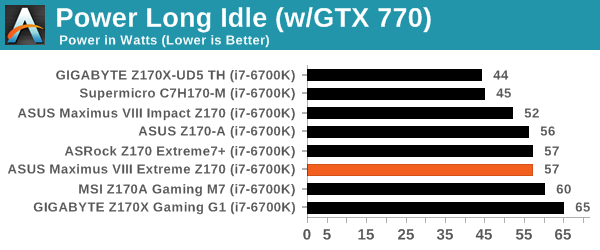
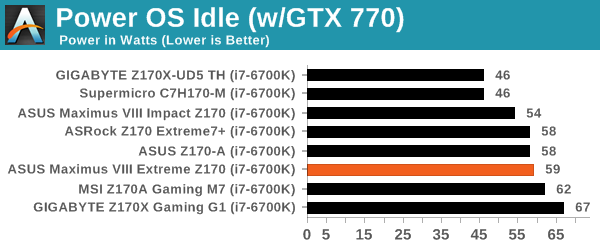
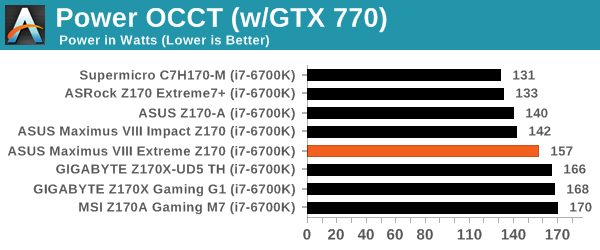
By the nature of being a large E-ATX motherboard with a number of extra controllers, one would expect the M8E to draw a fair bit of power, even under CPU load.
Non UEFI POST Time
Different motherboards have different POST sequences before an operating system is initialized. A lot of this is dependent on the board itself, and POST boot time is determined by the controllers on board (and the sequence of how those extras are organized). As part of our testing, we look at the POST Boot Time using a stopwatch. This is the time from pressing the ON button on the computer to when Windows 7 starts loading. (We discount Windows loading as it is highly variable given Windows specific features.)

Perhaps due to the emergence of Windows 10 and fast boot sequences, fewer motherboard companies are worrying about POST times, although they are now arguably the longest part of a start-up process, especially with the additional DDR4 training needed for validation. The Extreme is reasonably comfortable for its size at 16.50 seconds.
Rightmark Audio Analyzer 6.2.5
Rightmark:AA indicates how well the sound system is built and isolated from electrical interference (either internally or externally). For this test we connect the Line Out to the Line In using a short six inch 3.5mm to 3.5mm high-quality jack, turn the OS speaker volume to 100%, and run the Rightmark default test suite at 192 kHz, 24-bit. The OS is tuned to 192 kHz/24-bit input and output, and the Line-In volume is adjusted until we have the best RMAA value in the mini-pretest. We look specifically at the Dynamic Range of the audio codec used on board, as well as the Total Harmonic Distortion + Noise.

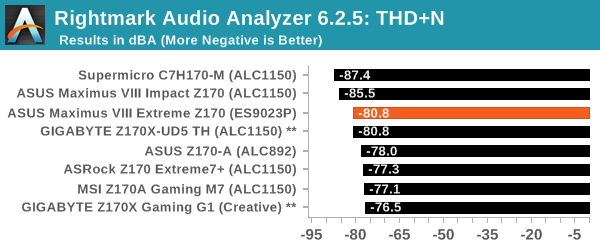
Audio performance from the Extreme gives it the highest SNR of any 100-series motherboard we’ve tested before.
USB Backup
For this benchmark, we transfer a set size of files from the SSD to the USB drive using DiskBench, which monitors the time taken to transfer. The files transferred are a 1.52 GB set of 2867 files across 320 folders – 95% of these files are small typical website files, and the rest (90% of the size) are small 30 second HD videos. In an update to pre-Z87 testing, we also run MaxCPU to load up one of the threads during the test which improves general performance up to 15% by causing all the internal pathways to run at full speed.
Due to the introduction of USB 3.1, as of June 2015 we are adjusting our test to use a dual mSATA USB 3.1 Type-C device which should be capable of saturating both USB 3.0 and USB 3.1 connections. We still use the same data set as before, but now use the new device. Results are shown as seconds taken to complete the data transfer.
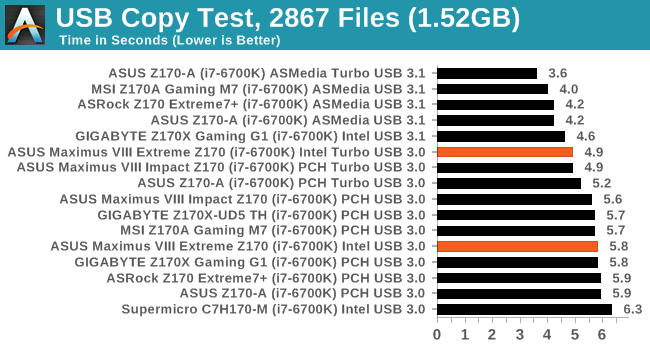
With ASUS’ USB Turbo, we get great performance in our USB 3.0 test. Unfortunately due to the nature of the Intel USB 3.1 controller, our testing software reports erroneous results stating that a transfer is complete faster than could be possible (and it’s a highly variable result). Interestingly we also had problems with the ASMedia controller, which behaved similarly.
DPC Latency
Deferred Procedure Call latency is a way in which Windows handles interrupt servicing. In order to wait for a processor to acknowledge the request, the system will queue all interrupt requests by priority. Critical interrupts will be handled as soon as possible, whereas lesser priority requests such as audio will be further down the line. If the audio device requires data, it will have to wait until the request is processed before the buffer is filled.
If the device drivers of higher priority components in a system are poorly implemented, this can cause delays in request scheduling and process time. This can lead to an empty audio buffer and characteristic audible pauses, pops and clicks. The DPC latency checker measures how much time is taken processing DPCs from driver invocation. The lower the value will result in better audio transfer at smaller buffer sizes. Results are measured in microseconds.

For better or worse, DPC Latency has been a wild ride on Z170. Some companies care deeply, others are not too fussed. Despite this, ASUS seems to have nailed down the formula for a great DPC Latency, and the Maximus VIII Extreme takes the crown from its smaller sibling in style.










70 Comments
View All Comments
romrunning - Thursday, April 7, 2016 - link
Yes - Thunderbolt3Jon Tseng - Thursday, April 7, 2016 - link
Do these sort of mobos have particularly high end audio integrated? I could see an argument for paying more if you e.g. replaced a $100+ high end audio card.Ditto I guess for the wifi, given a lot of mobos don't seem to have this build in (something I never quite understood why).
arayoflight - Thursday, April 7, 2016 - link
The Z170 deluxe has the same 3x3 MiMo WiFi ac built in and costs much less. I don't think there are 3x3 MiMo cards you can buy. The best I could find was the 2x2 intel one for around 70$.Don't know about sound quality, but it should be good.
extide - Thursday, April 7, 2016 - link
You could read the review, but yes, they have pretty good onboard audio.saratoga4 - Thursday, April 7, 2016 - link
I really wish Anandtech would test the headphone out with maybe 32 ohm headphones rather than just the line out. I'd gladly pay extra for a board with good headphone out, but right now it is almost impossible to know which manufacturers are skimping and which are providing a quality output.DominionSeraph - Friday, April 8, 2016 - link
You can get an Audigy FX for $28. $25 from AmazonWarehouseDeals. (price goes up and down a tad -- I got mine for $22)The ALC898 it uses is no slouch.
extide - Friday, April 8, 2016 - link
That would be a downgrade.jptech7 - Friday, April 8, 2016 - link
For someone wanting better headphone out performance than a high end motherboard, I would not recommend an Audigy FX. The ALC 898 is a downgrade from either the Sabre in this Asus or the ALC1150 found on most good mobos, and for that price, I doubt its ability to drive high end headphones.The included Sabre chip on this Asus board is a quality component, but there are still likely some limitations to integrated audio solutions. For the few people desiring greater performance on their headphone out line, a USB or TOSLINK based dedicated headphone DAC & amp can be had. Decent ones start around $100 and scale up from there.
I would expect the only reason to buy additional equipment in this case would be if you need to provide greater than 2V RMS that the Sabre line driver can provide which is already quite decent.
DominionSeraph - Friday, April 8, 2016 - link
He didn't say he wanted more than a $500 motherboard, he said he wanted to know the performance. I pointed out that the performance is pretty meaningless since the Audigy FX exists. Why would you spend $500 on a motherboard when you can grab a $120 one and throw a $25 card in there that will not only be an upgrade over the ALC892 (or worse) that it will have, but has a headphone driver as well.There will be no discernible difference between an ALC898 and a 1150.
Murloc - Thursday, April 7, 2016 - link
if you care about audio you're exiting it on hdmi anyway, so it'd be a waste of money.